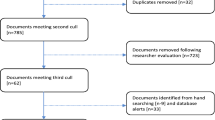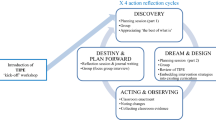Abstract
This case study discusses how educational entities collaborate in meaningful ways to address teaching force representation and shortages in critical fields for diverse populations in urban education settings. The authors examined how the role of a federally funded program, Academy for Teacher Excellence (ATE), at a Hispanic Serving Institution in Texas is creating preschool through university level (P-20) collaborative partnerships with various community stakeholders to enhance college access for minorities, specifically Latino students pursuing the teaching profession. Constant comparison analysis of the data uncovered the following themes: (a) Building Relationships and Dialoguing across Partners, (b) Communicating Information and Outreach, and (c) Networking and Leveraging Resources. Together, these foster a collaborative partnership among entities with the intention of maximizing synergy and supporting the access, recruitment, and education of Latino teacher candidates who will become culturally efficacious teachers of all students, but specifically for the growing number of Latino students in urban areas.
Similar content being viewed by others
References
Adelman, C. (2005). Moving into town-and moving on: The community college in the lives of traditional-age students. Washington, DC. US Department of Education. Retrieved from www.ed.gov/rschstat/research/pubs/comcollege/movingintotown.pdf.
Allen, R. (2002). Teacher education at the community college: Partnership and collaboration. (ERIC Document Reproduction No ED 467 986).
Auerbach, S. (2002). “Why do they give the good classes to some and not to others?” Latino parent narratives of struggle in a college access program. Teachers College Record, 104(7), 1269–1392.
Bergin, D. A., Cooks, H. C., & Bergin, C. C. (2007). Effects of college access program for youth underrepresented in higher education: A randomized experiment. Research in Higher Education, 48(6), 727–750.
Clark, E. R., & Flores, B. B. (2002). Narrowing the pipeline for ethnic minority teachers: Standards & high-stakes testing. Multicultural Perspectives, 4(2), 15–20.
Contreras, F. E. (2005). Access, achievement, and social capital: standardized exams and the Latino college-bound population. Journal of Hispanic Higher Education, 4(3), 197–214.
Dougthery, K. L., & Kienzl, G. S. (2006). It’s not enough to get through the open door: Inequalities by social background in transfer from community colleges to 4-year colleges. Teachers College Record, 108(3), 452–487.
Flores, B. B., Claeys, L., & Wallis, D. (2006). Academy for Teacher Excellence: Extending the dialogue in university and community college partnerships. Journal of Learning Communities Research, 1(1), 29–51.
Flores, B. B., & Clark, E. R. (2004). The Centurion: Standards and High-stakes testing as gatekeepers for prospective bilingual education teachers. In A. Valenzuela (Ed.), Leaving children behind: Why “Texas-Style” accountability fails Latino Youth. Albany: State University of New York Press.
Flores, B. B., Clark, E. R., Claeys, L. C., & Villarreal, A. (2007). Academy for Teacher Excellence: Recruiting, preparing, and retaining Latino teachers though learning communities. Teacher Education Quarterly, 34(4), 53–69.
Flores, B. B., Ek, L., & Sánchez, P. (2011). Bilingual education teachers’ ideology: Descubriendo sus motives y creencias. In B. B. Flores, R. H. Sheets & E. R. Clark (Eds.), Preparing teachers for bilingual student populations. Educar para Transformar. Routledge. (in press).
González, K. P., Stoner, C., & Jovel, J. E. (2003). Examining the social capital in access to collage for Latinas: Toward a college opportunity framework. Journal of Hispanic Higher Education, 2(1), 146–170.
González, R. (2007). Office of P-20 initiatives. Retrieved June 26, 2007 from http://www.utsap20.org/intro.php.
Hurtado, S., Inkelas, K. K., Briggs, C., & Rhee, B. (1997). Differences in college access and choice among racial/ethnic groups: Identifying continuing barriers. Research in Higher Education, 38(1), 43–75.
Jalomo, Jr., R. (1995). Latino students in transition: An analysis of the first-year experience in community college. Unpublished doctoral dissertation, College of Education, Arizona State University, Tempe.
Jones, E. B., Young, R., & Rodríguez, J. L. (1999). Identity and career choice among Mexican-American and Euro-American preservice teachers. Hispanic Journal of Behavioral Sciences, 21(4), 431–446. doi:10.1177/0739986399214004.
Laguardia, A. (1998/1999). A survey of school/college partnerships for minority and disadvantaged students. High School Journal, 82(2), 97–111.
Martínez, M. D. (2003). Missing in action: Reconstructing hope and possibility among Latino students placed at risk. Journal of Latinos and Education, 2(1), 13–21.
McCabe, R. H. (1999). 21st Century challenges: Global competition, population changes, and the need for educational parity. Presidency, 2(3), 14–19.
Meier, K. J., Wrinkle, R. D., & Polinard, J. L. (1999). Representative bureaucracy and distributional equity: Addressing the hard question. Journal of Politics, 61(4), 1025–1039.
Melguizo, T. (2009). Are community colleges an alternative path for Hispanic students to attain a bachelor’s degree? Teachers’ College Record, 111(1), 90–123.
Miles, M. B., & Huberman, A. M. (1994). Qualitative data analysis: An expandedsourcebook (2nd ed.). Thousand Oaks, CA: Sage.
Murdoch, S., White, S., Hoque, M. N., Pecotte, B., You, X., & Blakan, J. (2002). A summary of the Texas challenge in the twenty-first century: Implications of population change for the future of Texas. College Station: TAMU: Center for Demographic and Socioeconomic Research and Education.
Myers, D. A. (2008). Professional dialogue: The teacher as a service professional. Action in Teacher Education, 30(1), 4–11.
National Center for Education Statistics. (2009). How Black and White Students in Public Schools Perform on the National Assessment of Educational Progress. Available from: http://nces.ed.gov/nationsreportcard/pdf/studies/2009495.pdf.
National Center for Education Statistics. (2002). Integrated postsecondary education data system, “Fall Enrollment Survey” (IPEDS-EF:02), fall 2002, previously unpublished tabulation (December 2004). Available from http://nces.ed.gov/programs/coe/2005/section5/table.asp?tableID=294.
National Center for Education Statistics. (2008). Schools and Staffing Survey (SASS), Public School Teacher, BIE School Teacher, and Private School Teacher Data Files, 2007–2008. Table 2 Percentage distribution of school teachers, by race/ethnicity, school type, and selected school characteristics: 2007–2008. Available from http://nces.ed.gov/pubs2009/2009324/tables/sass0708_2009324_t12n_02.asp.
National Center for Education Statistics. (2007). Status and trends in the Education of racial and ethnic minorities. Available from http://nces.ed.gov/pubsearch/pubsinfo.asp?pubid=2007039.
National Center for Education Statistics. (2003). The release of the National Assessment of Educational Progress (NAEP) The Nation’s Report Card Trial Urban District Assessment, Reading 2002 and Writing 2002. Available from http://nces.ed.gov/whatsnew/commissioner/remarks2003/7_22_2003.asp.
National Collaborative on Diversity in the Teaching Force. (2004). Assessment of diversity in America’s teaching force: A call to action. Retrieved June 17, 2006 from http://www.nea.org/teacherquality/images/diversityreport.pdf.
National Comprehensive Center for Teacher Quality and Public Agenda [NCCTQ & PA]. (2007). Lessons learned: New teachers talk about their jobs, challenges and long-range plans, Issue #1. Retrieved November 26, 2007 from http://www.publicagenda.org/lessonslearned1/pdfs/lessons_learned_1.pdf.
Nelson, C. (Ed.). (1997). Will teach for food: Academic labor in crisis. Minneapolis: University of Minnesota Press.
Oliva, M. (2004). Reluctant partners, problem definition, and legislative intent: K-16 policy for Latino College Success. Journal of Hispanic Higher Education, 3(2), 209–230.
Quiocho, A., & Rios, F. (2000). The power of their presence: Minority group teachers and schooling. Review of Educational Research, 70(4), 485–528.
Padilla, R. V. (1999). College student retention: Focus on success. Journal of College Student Retention, Research, Theory & Practice, 1(2), 131–145.
Perna, L. W. (2000). Differences in the decision to attend college among African Americans, Hispanics, and Whites. The Journal of Higher Education, 71(2), 117–141.
Rendón, L. I. (1994). Validating culturally diverse students: Toward a new model of learning and student development. Innovative Higher Education, 19(1), 23–32.
Santiago, D. A. (2007). Choosing Hispanic-serving institutions (HSIs): A closer look at Latino student college choices. Excelencia in Education. Retrieved March 30, 2007 from http://www.edexcelencia.org/pdf/ChoosingHSIsCloserLookFINAL.pdf.
Saunders, M., & Serna, I. (2004). Making college happen: The college experiences of first-generation Latino students. Journal of Hispanic Higher Education, 3(2), 146–163.
Shulock, N. B., & Moore, C. (2005). Diminished access to baccalaureate for low-income and minority students in California: The impact of budget and capacity constraints on the transfer function. Educational Policy, 19(2), 418–442.
Slater, J. J., & Ravid, R. (2010). Slater’s School/University Collaborative Matrix. In J. J. Slater & R. Ravid (Eds.), Collaboration in education (pp. 10–11). New York: Routledge, Slater, J. J. (2008).
Swail, W. S., Cabrera, A. F., Lee, C., & Williams, A. (2005). Latino students and the educational pipeline. Educational Policy Institute. Retrieved March 30, 2007 from http://www.educationalpolicy.org/pdf/LatinoI.pdf.
Texas Higher Education Coordinating Board. (2007). Texas higher education assessment. Available from http://www.thecb.state.tx.us/Rules/tac3.cfm?Chapter_ID=4&Subchapter=C.
The Alliance for Equity in Higher Education. (2000). Educating the emerging majority: The role of minority-serving colleges & universities in confronting America’s Teacher Crisis. Retrieved September 21, 2004 from http://www.ihep.com/Pubs/PDF/FinalTeacherED.pdf.
Tinto, V. (1993). Leaving college. The causes and cures of student attrition (2nd ed.). Chicago: University of Chicago Press.
Tinto, V. (1997). Classrooms as communities: Exploring the educational character of student persistence. Journal of Higher Education, 68(6), 599–623.
US Census Data. (2009). Press release. Available from: http://www.census.gov/Press-Release/www/releases/archives/population/012496.htm.
US Department of Education. (2009). EDFacts state profiles. Available from (http://www2.ed.gov/about/inits/ed/edfacts/state-profiles/).
US Department of Education. (2002). State education indicators with a focus on title I. State profiles. Available from http://www2.ed.gov/rschstat/eval/disadv/2002indicators/edlite-summ.html.
Valencia, R. (Ed.). (2002). Chicano school failure and success: Past, present, and future (2nd ed.). New York: Routledge.
Valenciana, C., Morin, J. A., & Morales, R. S. (2005). Meeting the challenge: Building university-school district partnerships for a successful career ladder program for teachers of English learners. ACTION in Teacher Education, 27(1), 82–91.
Valenciana, C., Weisman, E. M., & Flores, S. Y. (2006). Voices and perspectives of Latina paraeducators: The journey towards teacher certification. The Urban Review, 38(2), 81–99.
Venezia, A. (2004). K-16 turmoil in Texas. In M. W. Kirst & A. Venezia (Eds.), From high school to college: Improving opportunities for success in postsecondary education (pp. 77–114). San Francisco, CA: Jossey-Bass.
Waterford, T., Rivas, M. A., Burciaga, R., & Solórzano, D.G. (2006). Latinas and the doctorate: The status of attainment and experiences from the margin. In J. Castellanos, A. M. Gloria & M. Kamimura (Eds.), (pp.113–133). Sterling, VA: Stylus Publishing.
Weiher, G. R. (2000). Minority student achievement: Passive representation and social context in schools. The Journal of Politics, 62(3), 886–896. doi:10.111/0022-3816.0038.
Wellman, J. V. (2002). State Policy and Community College-Baccalaureate transfer rate. The National Center for Public Policy and Higher Education and The Institute for Higher Education Policy. Available from http://www.csn.edu/PDFFiles/Counseling%20and%20Transfer/NACADA%202009/Higher%20Education%20Transfer%20Report.pdf.
Wilson, E. V. (2001). Pathways to Teacher Education: Factors critical to the retention and graduation of community college transfer pre-service students in teacher education programs. Inquiry, 6(2), 17–27.
Yin, R. K. (1994). Case study research: Design and methods. Thousand Oaks, CA: Sage Publications.
Zimpher, N. L., & Howey, K. R. (2005). The politics of partnerships for teacher education and school renewal. Journal of Teacher Education, 56(3), 266–271.
Zirkel, S. (2002). Is there a place for me? Role models and academic identity among White students and students of color. Teacher College Record, 104(2), 57–375.
Author information
Authors and Affiliations
Corresponding author
Rights and permissions
About this article
Cite this article
Flores, B.B., Claeys, L. Academy for Teacher Excellence: Maximizing Synergy Among Partners for Promoting College Access for Latino Teacher Candidates. Urban Rev 43, 321–338 (2011). https://doi.org/10.1007/s11256-010-0153-y
Published:
Issue Date:
DOI: https://doi.org/10.1007/s11256-010-0153-y




